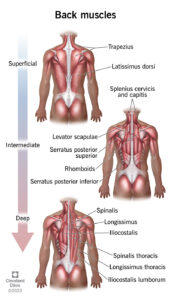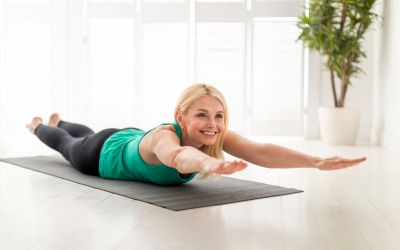Whether you want to improve your posture, prevent or reduce back pain, or tone up, knowing the best back exercises for women that will get the job done is essential.
Your back is your body’s powerhouse. Despite this, many of us overlook the importance of the best back exercises for women, specifically the four major muscle groups: Traps, Rhomboids, Lats, and Erector Spinae.
Whether you’re new to fitness or looking to strengthen your back, this guide will show you the best back exercises for women. From equipment-free movements to gym-based workouts, you’ll find everything you need to build a stronger, more capable back.
Understanding Your Back Muscles as a Woman
The complex network of muscles in your back represents one of the most powerful systems in your body. Your back contains approximately 40 different muscles working together to support movement, posture, and stability. For women, understanding these muscles isn’t just about esthetics—it’s about functionality, longevity, and overall wellbeing.
Key muscle groups in the female back
Your back muscles fall into three main categories, each serving distinct yet interconnected purposes. First, the superficial back muscles are what you typically see when looking at the back. These include the trapezius (traps), which extends from your neck to mid-back in a V-shape, the latissimus dorsi (lats)—the largest muscle in your upper body—running from shoulders to lower back, the rhomboids connecting your shoulder blades to your spine, and the levator scapulae that helps raise your shoulders.
Second, the intermediate back muscles connect to your ribcage and spine, playing a crucial role in your breathing process. These muscles include the serratus posterior superior (helps you breathe in) and the serratus posterior inferior (helps you breathe out).
Finally, the intrinsic back muscles lie deepest in your back and are considered the only “true” back muscles. These well-developed muscles include the erector spinae (running alongside your spine), splenius muscles (between upper back and neck), and transversospinal muscles (lining the upper spine). Essentially, these deep muscles work together to:
- Maintain proper posture and spinal alignment
- Enable bending, twisting, and extension movements
- Support weight-bearing activities
- Stabilize your spine during everyday movements

Why back strength matters for women
A strong back serves as the foundation for virtually every movement in your daily life. For this reason, back strength isn’t optional—it’s fundamental. Back muscles help you perform everyday activities such as putting on shoes, closing windows, or carrying groceries. Furthermore, they play a vital role in maintaining good posture, especially important for women who often spend hours looking down at phones or typing at computers.
Strong back muscles provide essential support to your spine, consequently reducing the likelihood of strains, sprains, and other injuries during lifting, bending, or twisting movements. In fact, weak core muscles combined with repetitive daily activities often lead to poor posture and eventual pain.
Moreover, back muscles help support your vertebrae, disks, ligaments, and facet joints. As a result, strengthening these muscles can improve your overall mobility and make physical activities more efficient. During pregnancy, a strong back becomes even more important as it helps manage the additional weight and postural changes that occur.
Common back issues women face
Women face unique back challenges throughout their lives, primarily due to hormonal fluctuations and anatomical differences. For instance, women typically have a smaller sacroiliac (SI) joint surface area compared to men, resulting in higher concentration of stresses across the joint. The sacrum is also wider, more uneven, less curved, and tilted more backward in women, which may cause problems in the SI joint.
Pain related to menstruation is another female-specific issue. Discomfort during menstrual periods often radiates to the lower back, hips, and legs. During pregnancy, back pain commonly develops between the fifth and seventh month but can start much earlier, especially for women with pre-existing back issues.
Post-menopausal women face additional challenges, as degenerative conditions become more common. In particular, women in this age group are four times more likely than men to develop osteoporosis, a condition where bone loss occurs faster than new bone formation. Likewise, facet joint arthritis (osteoarthritis) occurs more frequently in women, especially as age and weight increase.
Understanding these unique challenges makes it clear why targeted back exercises for women are not just beneficial but essential for long-term wellbeing and mobility.
Best Back Exercises for Women Without Equipment
Building a strong back doesn’t require expensive equipment or a gym membership. At home, you can perform effective exercises that target all the key muscles in your back. These bodyweight exercises are particularly valuable for beginners who want to establish proper form before progressing to weighted movements.
Superman holds for lower back strength
The Superman exercise effectively targets your erector spinae muscles, which provide crucial support to your spine. Furthermore, this exercise works your glutes, hamstrings, and shoulders simultaneously.
To perform a proper Superman:
- Lie facedown on a mat with your arms extended in front of you and legs straight behind you
- Engage your core by pulling your belly button toward your spine
- Simultaneously lift your arms, chest, and legs about 6 inches off the floor
- Hold this position for 2-3 seconds while breathing normally
- Lower back down with control and repeat
For beginners, start with 2-3 sets of 8-12 repetitions. Meanwhile, focus on quality over quantity, lifting only as far as feels comfortable without straining your lower back.
Above all, avoid common mistakes such as looking up (which hyperextends your neck), pointing your toes excessively, or lifting your limbs too high. Instead, keep your neck in a neutral position with a slight bend in your elbows and knees.

Bird dog for core and back stability
The bird dog exercise has been scientifically proven as one of the best exercises for spinal health, control, and stability. In essence, it teaches you to engage your abdominals while stabilizing your lower back during movement.
To perform the bird dog correctly:
- Start on all fours with knees under hips and hands under shoulders
- Engage your core to stabilize your spine
- Simultaneously extend your right arm forward and left leg backward
- Keep your shoulders and hips parallel to the floor
- Hold briefly, then return to the starting position
- Repeat with the left arm and right leg
Aim for 2 sets of 10 repetitions per side. Under those circumstances where balance is challenging, focus first on mastering the arm movements before adding the leg extensions.
The bird dog minimizes movement in your lower back—important to realize this is key to preventing injury. The exercise effectively works the entire core, including the erector spinae, rectus abdominis, and glutes, allowing for greater mobility in daily movements.

Modified pull-ups using household items
Pull-ups are excellent for building upper back strength, nevertheless, they can be challenging for beginners. Modified versions using household items offer a perfect starting point.
Try these household modifications:
- Doorway rows: Stand facing a doorway, grip both sides, lean back slightly, and pull yourself forward
- Towel rows: Secure a folded towel around a doorknob (on the side opposite to you), then perform rows by pulling the towel toward your abdomen
- Chair inverted rows: Place a broomstick across two sturdy chairs and perform inverted rows underneath it
For all variations, primarily focus on squeezing your shoulder blades together during the pulling motion. This engages your lats, rhomboids, and trapezius muscles effectively.
As you progress, you can increase difficulty by adjusting your body position. At the present time, these modified pull-ups might seem simple, but they build the foundation for eventually performing full pull-ups.
These equipment-free exercises create a comprehensive back workout that strengthens all major back muscles. Correspondingly, incorporating them into your routine 2-3 times weekly will help build the strength and stability needed for more advanced exercises later.
Best Back Exercises for Women Using Dumbbells
Dumbbells offer an excellent next step in your back-strengthening journey, providing just enough resistance to challenge your muscles without overwhelming them. Unlike machines, dumbbells allow free movement, helping you develop stabilizing muscles alongside primary back muscles.
Bent-over dumbbell rows for upper back
Bent-over dumbbell rows target multiple back muscles simultaneously, making them one of the most effective exercises for women looking to build upper back strength. This compound movement primarily works your trapezius, rhomboids, latissimus dorsi, and teres muscles—practically your entire back.
To perform this exercise correctly:
- Stand with feet shoulder-width apart, holding a dumbbell in each hand
- Hinge at your hips until your torso is nearly parallel to the floor
- Keep your back flat, core engaged, and knees slightly bent
- Pull the dumbbells toward your torso, driving elbows behind your body
- Squeeze your shoulder blades together at the top
- Slowly lower the weights to starting position
In brief, focus on maintaining a neutral spine throughout the movement. Subsequently, as you gain strength, gradually increase the weight rather than compromising form. Undeniably, controlling the movement is more important than how much weight you lift.
Single-arm rows for balanced strength
Single-arm rows offer unique benefits compared to traditional bent-over rows. At first, they might seem similar, nonetheless they excel at identifying and correcting strength imbalances between your left and right sides.
To perform single-arm rows properly:
- Place your left knee and hand on a bench for support
- Hold a dumbbell in your right hand, arm fully extended
- Keep your back parallel to the floor
- Pull the dumbbell up toward your hip, keeping your elbow close to your body
- Lower with control and repeat before switching sides
As well as fixing imbalances, single-arm rows increase power output compared to bilateral movements. Given that you’re focusing on one side at a time, you can better isolate the lats and achieve greater range of motion.
Reverse flies for shoulder and back definition
Reverse flies primarily target the often-neglected posterior deltoids and upper back muscles. In contrast to rows that emphasize mid-back, reverse flies focus on shoulder stability and back definition.
For proper reverse fly technique:
- Hinge forward at your hips with a flat back
- Hold dumbbells with a slight bend in your elbows
- Lift both arms out to the sides until parallel with the floor
- Focus on squeezing shoulder blades together
- Lower weights with control and repeat
Prior to attempting heavier weights, master proper form with lighter dumbbells. Think of the movement as “opening a book” with your arms. Thus, you’ll effectively target those posterior shoulder muscles that create that defined look between your shoulder blades.
Incorporate these dumbbell exercises into your routine 2-3 times weekly for optimal results, allowing rest days between sessions for recovery.
Gym-Based Best Back Exercises for Women Beginners
Stepping into the gym opens up a world of specialized equipment designed to target your back muscles more effectively. Gym machines offer controlled movement patterns that are perfect for beginners still mastering proper form.
Lat pulldown variations
The lat pulldown machine serves as an excellent starting point for strengthening your upper back, particularly the latissimus dorsi muscles. Initially, choose a weight that allows 10-12 controlled repetitions. To perform a basic lat pulldown:
- Sit facing the machine with knees secured under the pads
- Grip the bar slightly wider than shoulder-width
- Pull the bar down toward your chest while keeping your back straight
- Slowly return to starting position with arms extended
Try different grip variations to target diverse back muscles. Generally, a wider grip emphasizes the outer lats, while a closer grip works the middle back and biceps more intensely. For beginners, the underhand grip (palms facing you) tends to be easier since it recruits more bicep assistance.
Seated row technique
The seated cable row builds strength throughout your middle back muscles, including the rhomboids and trapezius. Proper technique is crucial to prevent injury:
- Sit on the bench with feet firmly on the footplates
- Grasp the handle with arms extended
- Pull the handle toward your lower abdomen
- Squeeze your shoulder blades together at the peak of the movement
Throughout the exercise, maintain a straight back—never round or hunch forward. In addition to strengthening your back, this exercise improves posture by training the muscles that pull your shoulders backward.
Assisted pull-up progression
Since pull-ups can be challenging for beginners, the assisted pull-up machine provides gradual progression toward unassisted versions. After setting an appropriate counterweight:
- Grip the handles with palms facing away
- Step onto the platform or kneel on the pad
- Pull yourself up until your chin clears the bar
- Lower yourself slowly to maximize muscle engagement
Gradually decrease the assistance weight as you build strength. Following consistent practice, you’ll notice impressive improvements in your upper back and arm strength that transfer to daily activities.
Creating Your First Back Workout Routine
Now that you’re familiar with various back exercises, let’s put them together into an effective workout routine. Creating a balanced back workout for women requires thoughtful planning to ensure optimal results and prevent injury.
How to structure a beginner-friendly session
First thing to remember when designing your back workout is simplicity. As a beginner, start with just 2-4 exercises that target different areas of your back. To begin with, perform 2-3 sets of 8-12 repetitions for each exercise with proper form. Certainly, warming up is essential—spend 5-10 minutes doing light cardio followed by dynamic stretches before starting your workout.
A well-structured back workout might look like this:
- Start with a compound movement (like assisted pull-ups or lat pulldowns)
- Move to a rowing exercise (bent-over rows or seated rows)
- Add a lower back exercise (Superman holds)
- Finish with a postural exercise (reverse flies)
Rest 2-3 minutes between sets if your goal is strength and muscle development. This rest period is crucial for proper muscular recovery between sets.
Balancing back exercises with other workouts
To clarify, your back training shouldn’t exist in isolation. Indeed, one effective approach is following a push-pull-legs routine where you train pushing movements (chest, shoulders, triceps) one day, pulling movements (back, biceps) another day, and legs separately. Although full-body workouts are also excellent for beginners, allowing you to train your entire body 2-3 times weekly with less time commitment.
Accordingly, aim to train your back 1-2 times per week, allowing 48-72 hours of recovery between sessions.
Weekly progression plan with the Best Back Exercises for Women beginners
After all, improvement requires progressive overload. Coupled with consistent practice, try to improve at least one aspect of your workout each week. This might include:
- Adding one more repetition to each set
- Slightly increasing the weight (even by 1-2 pounds)
- Improving form and range of motion
- Decreasing rest time between sets (if endurance is your goal)
To this end, keep a workout journal to track your progress and identify areas for improvement as you build your stronger, more capable back.
Best Back Exercises for Women Conclusion
Building a strong, capable back requires dedication and proper technique. Above all, remember that your back muscles play a vital role in everyday movements, posture, and overall well-being.
Certainly, starting with bodyweight exercises helps master proper form before progressing to dumbbells and gym equipment. Your journey toward a stronger back should follow a steady progression, focusing on quality movements rather than rushing to lift heavier weights.
Additionally, maintaining consistency with your back exercises helps prevent common issues many women face, from poor posture to chronic pain. Regular practice of these exercises, combined with proper rest periods, creates lasting strength and stability.
Therefore, start incorporating these back-strengthening exercises into your fitness routine today. Focus on mastering each movement, listen to your body, and gradually increase intensity as you become stronger. Finally, remember that a strong back not only enhances your physical appearance but also improves your quality of life through better posture, reduced pain, and increased confidence.
Best Back Exercises for Women FAQs
What are the Best Back Exercises for Women beginners?
For beginners, bodyweight exercises like Superman holds, bird dogs, and modified pull-ups are great to start with. As you progress, you can incorporate dumbbell exercises such as bent-over rows, single-arm rows, and reverse flies. When ready for gym equipment, try lat pulldowns, seated rows, and assisted pull-ups.
How often should women train their back muscles?
It’s recommended to train your back 1-2 times per week, allowing 48-72 hours of recovery between sessions. This frequency allows for adequate muscle recovery and growth while preventing overtraining.
Can back exercises help improve posture?
Yes, regular back exercises can significantly improve posture. Exercises like reverse flies and seated rows strengthen the muscles that pull your shoulders backward, counteracting the forward slouch common in daily activities like working at a computer.
What’s are good beginner-friendly Best Back Exercises for Women?
A simple yet effective routine could include 2-3 sets of 8-12 repetitions of the following: start with assisted pull-ups or lat pulldowns, move to bent-over rows or seated rows, add Superman holds for lower back, and finish with reverse flies for posture improvement. Remember to warm up before starting and rest between sets.
How can women track progress when doing the Best Back Exercises for Women?
Keep a workout journal to track your progress. Each week, try to improve one aspect of your workout, such as adding one more repetition to each set, slightly increasing the weight, improving form and range of motion, or decreasing rest time between sets if endurance is your goal.


